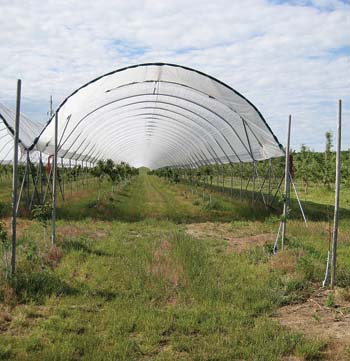Hoxsie’s Farm Market is ideally located to serve a million tourists during the week of July 4—but he needs sweet cherries to attract them.
 The National Cherry Festival drew a million people to Traverse City, Michigan, during the week starting July 4 last year, and, as the name says, it’s all about celebrating cherries. Half of the nation’s tart cherries and a fair amount of sweet cherries are grown in five counties surrounding the city.
The National Cherry Festival drew a million people to Traverse City, Michigan, during the week starting July 4 last year, and, as the name says, it’s all about celebrating cherries. Half of the nation’s tart cherries and a fair amount of sweet cherries are grown in five counties surrounding the city.
There’s only one problem: Neither fresh sweet cherries nor tart cherries are ordinarily available July 4 in that area. In most years, sweet cherries can be brought in from southern Michigan, where the crop is supposed to ripen in late June, and sometimes they come from the West Coast. Last year, because of cool spring conditions in the Pacific Northwest and Michigan, only California cherries were available on the Fourth of July.
That situation led Dennis Hoxsie to make a large investment in some new technology: high tunnels for sweet cherries. The idea is to have them ripen earlier, when all those tourists come, hungry for cherries.
Dennis and his wife, Judy, operate Hoxsie’s Farm Market just outside Traverse City. It’s part of a fifth-generation, 275-acre family farm that grows 130 acres of cherries, 15 acres of apples, plus pumpkins, squash, gourds, and vegetables, all of which join baked goods and other homemade products in the farm market.
While the cost of the high tunnels was, in his words, “somewhat prohibitive,” having cherries in time for the National Cherry Festival could make all the difference. “We will pay for the tunnels that way,” he said. That’s the goal, anyway.
Cracking
Hoxsie isn’t the first to plant cherries in high tunnels. Across the Midwest and East, large sweet cherries are virtually impossible to grow in the rainy, humid conditions because of fruit cracking. Protecting the cherries from rain greatly reduces cracking.
Hoxsie wants to gain another advantage. By covering the trees early in the season, he thinks he can gain enough heat to get ripe cherries by July 1—about two weeks ahead of normal.
In 2008, Hoxsie planted six, 600-foot rows of five sweet cherry varieties—one acre—and covered them with three bays of Haygrove tunnels, each 24 feet wide and 600 feet long. He planted Chelan, Tieton, Burgundy, Rainier, and Selah varieties on Gisela 5 rootstock. Trees were planted five feet apart in rows 12 feet apart, two rows per bay, with six feet between each row and the wall. All five varieties were planted in each bay because, Hoxsie said, it will potentially allow him to cover each bay at a different time and stagger ripening.
A double line of drip irrigation tape was installed on each row, to allow him to water the trees on the light, sandy soil and provide fertilizer as well.
“Denny is kind of the guinea pig,” said Nikki Rothwell, the Michigan State University Extension educator at the Northwest Michigan Horticulture Research Station nearby. She organized an International Fruit Tree Association tour to the area, and to Hoxsie’s, in March.
Most sweet cherry growers in the area grow cherries for brining and processing, so they grow different varieties. Fresh sweet cherry sales are incidental. The trees are bigger—on Mazzard or Mahaleb rootstocks—so Hoxsie’s choice of Gisela, especially on sandy soils, is another risky choice.
In addition, his farm market is in a lake-effect snow belt.
“We will need to cover early to grow the West Coast varieties,” he said. “But we can’t cover so early we take a chance of a big snow collapsing the tunnels.”
Still, he said, “Having cherries on July 1 would be a huge advantage.”
Hoxsie invested more than $30,000 to cover the acre of cherries. But having 10 tons of sweet cherries ready to sell to a million cherry-hungry tourists at $3 to $4 a pound proved an irresistible temptation.

Leave A Comment